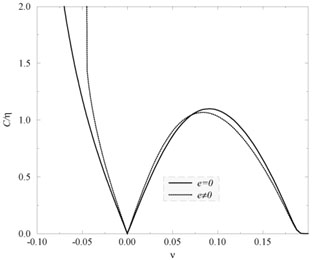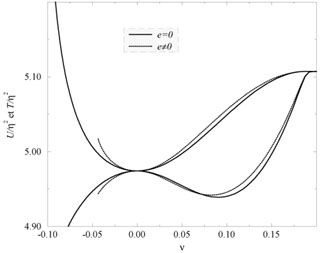


3.4. Macroscopic string description
Let us recapitulate briefly the microphysics setting before we see its
connection with the macroscopic string description we will develop
below. We consider a Witten-type bosonic superconductivity model in
which the fundamental Lagrangian is invariant under the action of a
U(1) × U(1) symmetry group. The first U(1) is spontaneously
broken through the usual Higgs mechanism in which the Higgs field
 acquires a non-vanishing
vacuum expectation value. Hence, at an energy scale ms ~
acquires a non-vanishing
vacuum expectation value. Hence, at an energy scale ms ~

 1/2
1/2
 (we will call
ms = m hereafter) we are left with a network of
ordinary
cosmic strings with tension and energy per unit length T ~
U ~ m2, as dictated by the Kibble mechanism.
(we will call
ms = m hereafter) we are left with a network of
ordinary
cosmic strings with tension and energy per unit length T ~
U ~ m2, as dictated by the Kibble mechanism.
The Higgs field is coupled not only with its associated gauge vector
but also with a second charged scalar boson
 , the current
carrier field, which in turn obeys a quartic potential. A second
phase transition breaks the second U(1) gauge (or global, in the case
of neutral currents) group and, at an energy scale ~
m*, the
generation of a current-carrying condensate in the vortex makes the
tension no longer constant, but dependent on the magnitude of the
current, with the general feature that T
, the current
carrier field, which in turn obeys a quartic potential. A second
phase transition breaks the second U(1) gauge (or global, in the case
of neutral currents) group and, at an energy scale ~
m*, the
generation of a current-carrying condensate in the vortex makes the
tension no longer constant, but dependent on the magnitude of the
current, with the general feature that T
 m2
m2
 U, breaking
therefore the degeneracy of the Nambu-Goto strings (more below).
The fact that
|
U, breaking
therefore the degeneracy of the Nambu-Goto strings (more below).
The fact that
| |
|
 0 in the string results in
that either electromagnetism
(in the case that the associated gauge vector
A(
0 in the string results in
that either electromagnetism
(in the case that the associated gauge vector
A( )µ is
the electromagnetic potential) or the global U(1) is spontaneously
broken in the core, with the resulting Goldstone bosons carrying
charge up and down the string.
)µ is
the electromagnetic potential) or the global U(1) is spontaneously
broken in the core, with the resulting Goldstone bosons carrying
charge up and down the string.
Macroscopic quantities
So, let us define the relevant macroscopic quantities needed to find the string equation of state. For that, we have to first express the energy momentum tensor as follows

| (33) |
One then calculates the macroscopic quantities internal to the string worldsheet (recall `internal' means coordinates t,z)

| (34) |
The macroscopic charge density/current intensity is defined as

| (35) |
Now, the state parameter is 
 sgn(w)
|w|1/2. For
vanishing coupling e we have w ~ k2 -
sgn(w)
|w|1/2. For
vanishing coupling e we have w ~ k2 -
 2 and
2 and
 yields
the energy of the carrier (in the case w < 0) or its momentum
(w > 0).
yields
the energy of the carrier (in the case w < 0) or its momentum
(w > 0).
We get the energy per unit length U and the tension of the string
T by diagonalizing
 ab
ab

| (36) |

|

|
Figure 1.8. Variation of the relevant
macroscopic quantities with the state parameter.
In the left panel we show the variation of the amplitude of the
macroscopic (integrated) charge density (for w < 0) and current
intensity (for w > 0) along the string core versus the state
parameter, as defined by |
As shown in Figure (1.8) the general string dynamics in the neutral case does not get much modified when the electromagnetic e-coupling is included. Nevertheless, a couple of main features are worth to note:

 and the tension tends
to vanish T
and the tension tends
to vanish T
 0+. An analytic treatment shows that C
0+. An analytic treatment shows that C
 (w +
m
(w +
m
 2)-1, with
m
2)-1, with
m 2 = 2 f
(
2 = 2 f
( 2
- v2). Note that this threshold changes with
the coupling, when e is very large.
2
- v2). Note that this threshold changes with
the coupling, when e is very large.
Macroscopic description
Now, let us focus on the macroscopic string description. For a local U(1) we have

| (37) |
[to stick to usual notation in the literature, we are now changing
e -
e in our expressions of previous sections].
In this equation we have the conserved Noether current
-
e in our expressions of previous sections].
In this equation we have the conserved Noether current

| (38) |
Now, recall that
Aµ( ) varies little inside the core, as
the penetration depth was bigger than the string core radius.
We can then integrate to find the macroscopic current
) varies little inside the core, as
the penetration depth was bigger than the string core radius.
We can then integrate to find the macroscopic current

| (39) |
which is well-defined even for electromagnetic coupling
e  0.
0.
The macroscopic dynamics is describable in terms of a Lagrangian
function  (w)
depending only on the internal degrees of
freedom of the string. Now it is
(w)
depending only on the internal degrees of
freedom of the string. Now it is
 's gradient that
characterizes local state of string through
's gradient that
characterizes local state of string through

| (40) |
where
 ab
is the induced metric on the worldsheet.
The latter is given in terms of the background spacetime metric
gµ
ab
is the induced metric on the worldsheet.
The latter is given in terms of the background spacetime metric
gµ with respect to the 4-dimensional
background coordinates xµ of the worldsheet.
We use a comma to denote simple partial differentiation with respect to
the worldsheet coordinates
with respect to the 4-dimensional
background coordinates xµ of the worldsheet.
We use a comma to denote simple partial differentiation with respect to
the worldsheet coordinates
 a
and using Latin indices for the worldsheet coordinates
a
and using Latin indices for the worldsheet coordinates
 1 =
1 =
 (spacelike),
(spacelike),
 0 =
0 =
 (timelike). As we saw
above, the gauge covariant derivative
(timelike). As we saw
above, the gauge covariant derivative
 |a is
expressible in the presence of a background
electromagnetic field with Maxwellian gauge covector
Aµ(
|a is
expressible in the presence of a background
electromagnetic field with Maxwellian gauge covector
Aµ( ) (Aµ hereafter) by
) (Aµ hereafter) by
 |a
=
|a
=  ,
a - eAµ
xµ,a.
So, now a key rôle is played by the squared of
the gradient of
,
a - eAµ
xµ,a.
So, now a key rôle is played by the squared of
the gradient of  in
characterizing the local state of the string through w.
in
characterizing the local state of the string through w.
The dynamics of the system is determined by the Lagrangian
 (w). Note there
is no explicit appearance
of
(w). Note there
is no explicit appearance
of  in
in
 . From it we get the
conserved particle current vector za, such that
. From it we get the
conserved particle current vector za, such that

| (41) |
Let's define -d / dw = 1/2
/ dw = 1/2
 -1.
Matching Eqns. (41) and (39), viz.
za (macro)
-1.
Matching Eqns. (41) and (39), viz.
za (macro)
 Ia (micro) we find
Ia (micro) we find

| (42) |
which allows us to see the interpretation of the quantity
 -1.
In fact, we have
-1.
In fact, we have
 -1
-1


 amplitude of
amplitude of  -condensate.
When w
-condensate.
When w
 0 (null) we
have
0 (null) we
have

 1.
(with
1.
(with  0 the
zero current limit of
0 the
zero current limit of
 ).
).